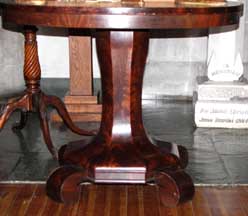Illustrated Architecture Dictionary ............... Illustrated FURNITURE Glossary
Late Classicism style
Also called Pillar and Scroll
1835-1850

Neoclassicism was the dominant style in Europe during the late 18th and early 19th centuries. In America, there are three parallel phases of Neoclassicism:
Some authors do not distinguish between Empire and Late Classical, regarding late Classical simply as Empire.
During the 1830s and 1840s, standard Empire designs became,more curvilinear as the Empire style was being replaced by the Rococo Revival. An even greater massiveness came to dominate furniture design, and plain, undecorated surfaces and scroll supports appeared.
French Restauration 1830-1870
After the French monarchy was restored, the period included the reigns of Louis XVIII, Charles X, Louis-Philippe, and Napoleon III. Napoleon III's reign is commonly referred to as Second Empire.
Eclectic designs and cheaper machine production marked this Second Empire period.
Joseph Meeks & Sons
One of the most important cabinet-making firms to disseminate this last phase of Classicism in America was Joseph Meeks & Sons (active 1797-1868) of New York. A lithograph printed in 1833 for the firm by Endicott & Semett shows forty-one pieces of furniture and two sets of draperies; this is the first known American print to illustrate complete furniture designs.
Popular furniture in this style tended to contain projecting columns in the French manner and an extraordinary use of S- and C-scrolls. Indeed, it might be said that the scroll represents the key to the style of the 1830s. By then, the massive architectural lines of this furniture were virtually all that remained of the classical influence.
John Hall
The style, sometimes called pillar and scroll, was widely popularized through a Baltimore publication of 1840, John Hall's The Cabinet Maker's Assistant, which contained 198 plates showing furniture forms whose design was completely dominated by single and double scrolls. Hall believed that the elliptical curve was the most beautiful single ingredient of design, and he combined S- and C-scrolls in every conceivable way.
Because his designs were intended for inexpensive furniture, the individual parts could be cut simply with a bandsaw, and the base wood was generally pine or tulip poplar whose surface was veneered with mahogany.
Examples:
- Illustration above: St. John's Grace Episcopal Church
- Table - Horace Reed House
- Lyre trestle table - Private collection, Buffalo, NY
- Scroll pedestal table - Ansley Wilcox Mansion / Theodore Roosevelt Inaugural Site
- Scroll pedestal table with drawers - Ansley Wilcox Mansion / Theodore Roosevelt Inaugural Site
- Pier table - Hoover House, Amherst Museum
- Pier table - Elliott House, Amherst Museum
- Breakfast table - Livingston- Backus House, Genesee Country Village, & Museum
- Richard and Gloria Manney Greek Revival Parlor - Metropolitan Museum of Art
- Sideboard - Hoover House, Amherst Museum
- Drop lid desk - Private collection, Amherst, NY
- Prince & Company melodeon - Boies-Lord House (Hamburg)
- Drop leaf table - Boies-Lord House (Hamburg)
- Server - Boies-Lord House (Hamburg)
- Work table - Boies-Lord House (Hamburg)
